Designing your dream home decor can be a daunting task, but with the right tools, it can become a fun and creative journey. One such tool is a mood board, a visual representation of your design ideas that helps you visualize the end result and avoid costly design mistakes.
A mood board is more than just a collage of images; it’s a guide that brings your design ideas together, ensuring your space reflects your personal style. By using tools like Canva, you can easily create a home decor mood board that captures your desired aesthetic.
Key Takeaways
- Understand the importance of a mood board in achieving your desired home decor.
- Learn how to visualize your design ideas effectively.
- Discover tools like Canva for creating a mood board.
- Avoid costly design mistakes with a clear design plan.
- Reflect your personal style in your home decor.
What Is a Home Decor Mood Board?
In the world of interior design, a mood board serves as a visual representation of a design concept. It’s a powerful tool that helps homeowners and designers visualize their ideas and bring them to life.
Definition and Purpose
A home decor mood board is essentially a collage of images, materials, and text that collectively convey the aesthetic and feel of a design project. Its primary purpose is to provide a clear direction for the design process, ensuring that all elements work together cohesively.
How Mood Boards Guide Your Design Process
Mood boards play a crucial role in guiding the design process by allowing you to visualize your ideas and make informed decisions. They help in two significant ways:
Visualizing the End Result
By creating a visual representation of your design concept, you can better imagine the final outcome of your project. This helps in making decisions about colors, textures, and furniture.
Preventing Costly Design Mistakes
A mood board can help prevent costly mistakes by identifying potential design issues early on. It allows you to experiment with different elements and make changes before committing to a specific design.
Here’s a simple comparison of the benefits of using a mood board:
| Benefits | Description |
|---|---|
| Visual Clarity | Helps in visualizing the design concept clearly |
| Design Consistency | Ensures that all design elements work together cohesively |
| Cost Efficiency | Prevents costly design mistakes by identifying issues early |
Why Creating a Home Decor Mood Board Is Essential
A well-crafted mood board is essential for bringing your design vision to life. It serves as a visual representation of your ideas, helping you to clarify and refine your design goals.
Visualizing Your Design Before Committing
One of the primary benefits of creating a mood board is that it allows you to visualize your design before committing to it. By gathering images, colors, and textures that inspire you, you can get a better sense of how your design will come together. This can help you avoid costly mistakes and ensure that your final design meets your expectations.
Maintaining Design Consistency
A mood board also helps maintain design consistency throughout your project. By establishing a clear visual direction from the outset, you can ensure that all elements of your design work together cohesively. This is particularly important when working with multiple contractors or designers, as it provides a shared vision for the project.
Communicating Ideas with Professionals
When working with interior designers or contractors, a mood board can be an invaluable tool for communicating your ideas. It provides a clear and concise visual representation of your design goals, making it easier for professionals to understand your vision and bring it to life.
Working Effectively with Interior Designers
By sharing your mood board with your interior designer, you can ensure that they’re on the same page as you. This can help streamline the design process, reducing the risk of miscommunication and ensuring that your final design meets your expectations.
Guiding Contractors and Craftspeople
A mood board can also be used to guide contractors and craftspeople, providing them with a clear understanding of the materials, colors, and textures you’re using. This can help ensure that the final product is consistent with your design vision.
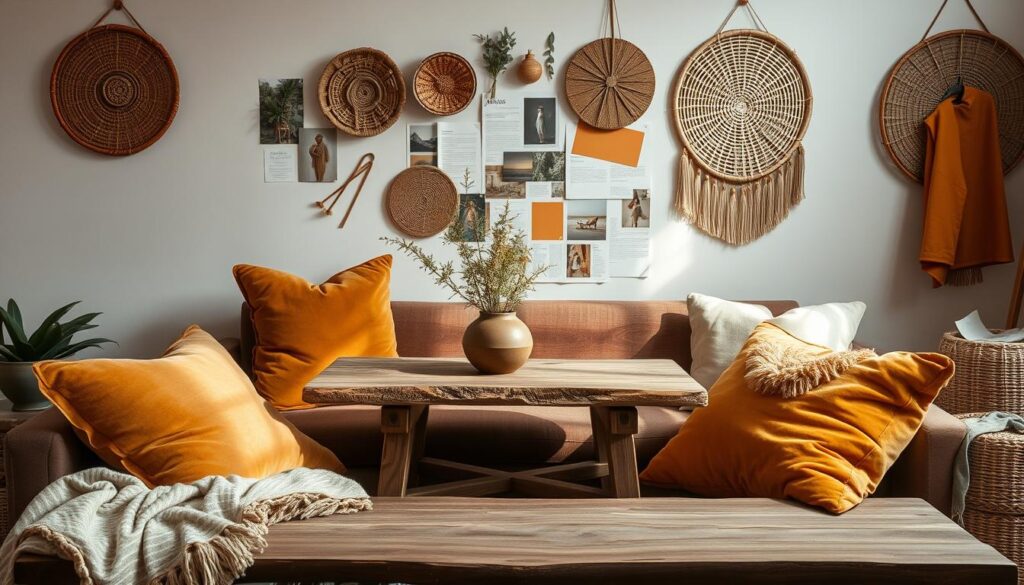
Physical vs. Digital Mood Boards: Choosing Your Medium
When it comes to creating a mood board for home decor, one of the first decisions you’ll need to make is whether to go digital or stick with a physical board. Both methods have their advantages and can cater to different needs and preferences.
Traditional Physical Mood Boards
Physical mood boards offer a tactile experience, allowing you to touch and feel the materials and textures you’re considering for your home decor.
Materials Needed
To create a physical mood board, you’ll need a board (such as cork or foam), along with items like fabric swatches, paint samples, magazine cutouts, and any other materials that inspire your design.
Assembly Techniques
Arrange your collected materials on the board in a way that feels visually appealing. You can use pins, glue, or other adhesives to secure items in place.
Digital Mood Board Platforms
Digital mood boards, on the other hand, offer flexibility and ease of editing. They can be especially useful when working with designers or when you need to make changes on the go.
Popular Apps and Websites
Tools like Canva and other mood board software for home decor have made it easy to create professional-looking digital mood boards. These platforms often include templates and a wide range of design elements.
Digital Organization Tips
Keep your digital mood board organized by using folders, tags, and clear naming conventions. This will help you quickly find and adjust elements as needed.
| Feature | Physical Mood Boards | Digital Mood Boards |
|---|---|---|
| Tactile Experience | Yes | No |
| Ease of Editing | No | Yes |
| Collaboration | Limited | Easy |
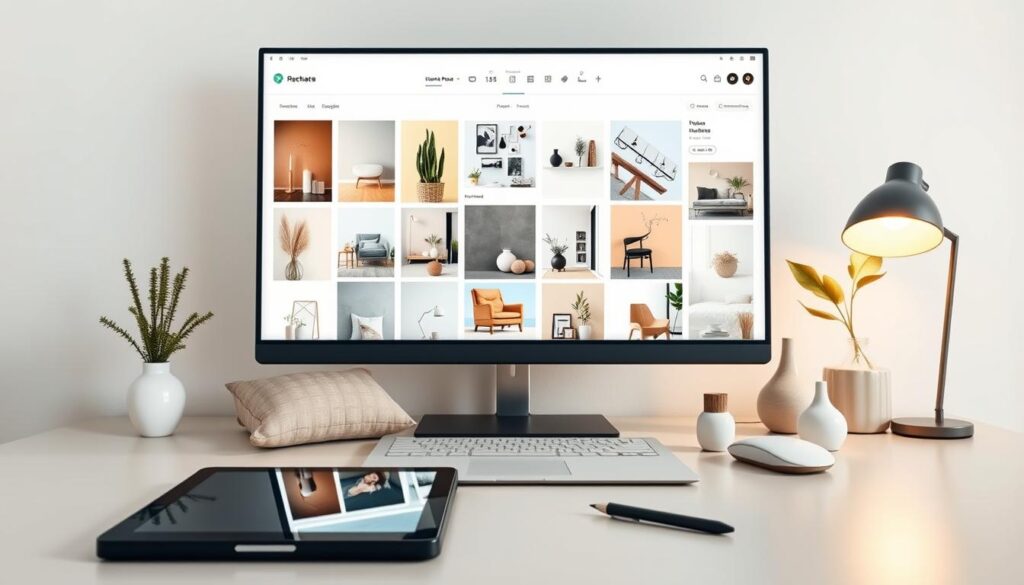
Ultimately, the choice between a physical and digital mood board comes down to your personal preference and the specific needs of your project. Many people find that using both methods in tandem works best for their home decor design process.
Gathering Inspiration for Your Mood Board
Inspiration is the foundation of any great design, and for your mood board, it can come from a multitude of places. The key is to remain open to new ideas and experiences that can influence your home decor.
Online Resources for Home Decor Ideas
The internet is a treasure trove of home decor inspiration. You can find a vast array of styles, trends, and ideas on various online platforms.
Social Media Platforms for Inspiration
Social media platforms like Instagram and Pinterest are excellent sources for home decor inspiration. They offer a visual feast of different styles and trends.
Design Blogs and Websites
Design blogs and websites are another rich source of inspiration. They often feature articles on the latest trends, decorating tips, and before-and-after makeovers.
Print Media and Design Books
While online resources are vast, print media and design books offer a tactile experience that can be very inspiring. Flipping through the pages of a well-designed book can spark creativity.
Real-World Inspiration Sources
Sometimes, the best inspiration comes from real-world experiences. Visiting places like showrooms, model homes, hotels, and restaurants can give you a firsthand look at different design styles.
Showrooms and Model Homes
Showrooms and model homes are designed to showcase the latest trends and designs. They provide an opportunity to see furniture, fixtures, and decor in a real-world setting.
Hotels and Restaurants
Hotels and restaurants often have unique designs that can be a great source of inspiration. Pay attention to the color schemes, lighting, and overall ambiance.
By gathering inspiration from these diverse sources, you can create a mood board that truly reflects your design aspirations.
| Source | Description | Benefits |
|---|---|---|
| Social Media | Visual platforms like Instagram and Pinterest | Visual inspiration, latest trends |
| Design Blogs | Websites featuring decorating tips and trends | In-depth articles, decorating advice |
| Showrooms | Physical spaces showcasing furniture and decor | See designs in real life, tactile experience |
Essential Elements to Include in Your Home Decor Mood Board
Creating a home decor mood board is an exciting step in designing your dream space, allowing you to visualize your ideas before bringing them to life. A comprehensive mood board serves as a visual guide, helping you stay focused on your design goals and ensure a cohesive final result.
Color Palettes and Swatches
Selecting the right color palette is crucial for setting the tone of your space. Include paint swatches, fabric samples, or digital representations of your chosen colors to create a unified color scheme. This will help you achieve a harmonious look throughout your home.
Texture and Material Samples
Incorporating various textures and materials adds depth to your mood board. Consider including samples of wood, fabric, metal, or other materials that will be used in your design. This will give you a better understanding of how different elements will work together.
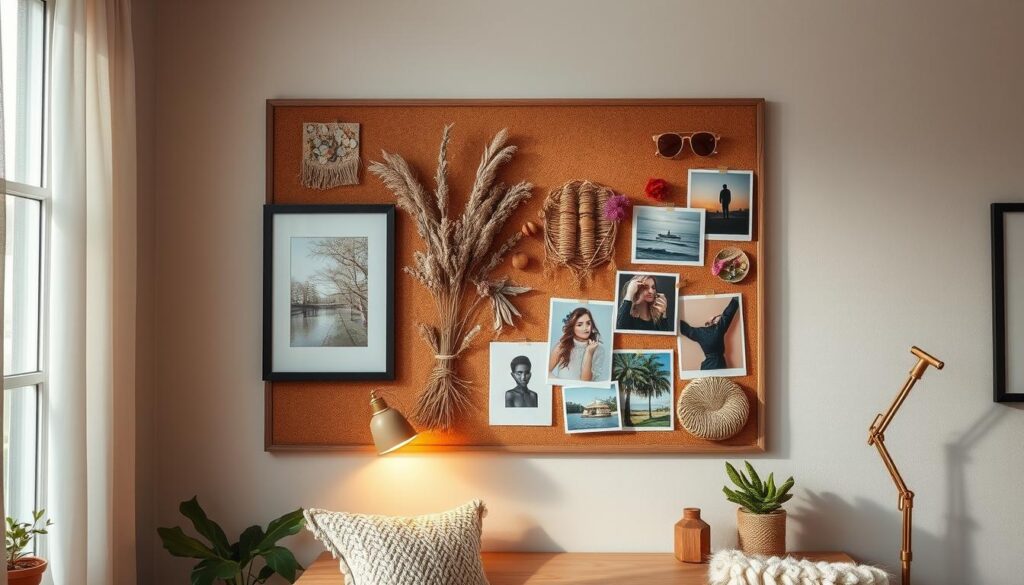
Furniture and Fixture Styles
Include images or sketches of the furniture and fixtures you plan to use. This could range from modern sofas to vintage decorative pieces. By visualizing these elements together, you’ll be able to identify any potential style conflicts early on.
Lighting Concepts
Lighting can dramatically impact the ambiance of a room. Add ideas for lighting fixtures or concepts to your mood board to ensure that your space is both functional and aesthetically pleasing.
Architectural Details
If you’re working with existing architectural features or planning to add new ones, include these details in your mood board. This could include trim work, molding, or other elements that contribute to the overall character of your space.
By incorporating these essential elements into your home decor mood board, you’ll be well on your way to creating a cohesive and beautiful space that reflects your personal style. Whether you’re using a physical or digital mood board, the key is to have fun and be creative with the process.
Step-by-Step Guide to Creating a Home Decor Mood Board
To bring your home decor ideas to life, follow this step-by-step guide to creating a mood board. A well-crafted mood board is essential for visualizing your design goals and maintaining consistency throughout your project.
Defining Your Design Goals
Before starting your mood board, it’s crucial to define your design goals. Consider the style, atmosphere, and functionality you want to achieve in your space. Ask yourself: What is the primary purpose of the room? What emotions do you want to evoke? Jot down your ideas and preferences to guide your mood board creation.
Selecting Your Core Color Palette
Your color palette is the foundation of your mood board. Choose 2-3 core colors that reflect your desired mood and style. You can draw inspiration from various sources, such as nature, art, or fashion. Use online color palette generators or consult with design experts to find the perfect combination.
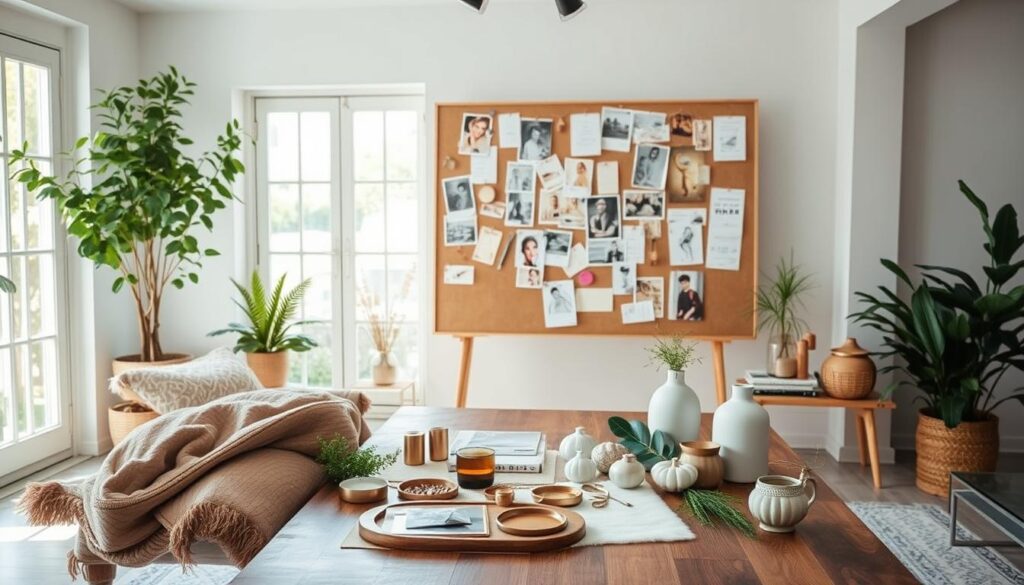
Curating Images and Samples
Gather images, textures, and samples that resonate with your design goals and color palette. You can use physical materials like fabric swatches, paint samples, and magazine cutouts, or digital elements like photos and online inspiration. Ensure that your selections are cohesive and representative of your desired aesthetic.
Arranging Your Elements Effectively
The arrangement of your mood board elements is crucial for visual impact. Consider the principles of visual hierarchy and balance to create a harmonious composition.
Creating Visual Hierarchy
Establish a clear visual hierarchy by varying the size, texture, and placement of your elements. Dominant elements should draw the eye first, while secondary elements provide supporting context.
Balancing Colors and Textures
Balance your color palette by distributing hues and textures thoughtfully. Mix contrasting elements to add depth and interest, but avoid overwhelming the composition. Strive for a harmonious blend that reflects your design vision.
By following these steps and tips, you’ll be able to create a comprehensive home decor mood board that guides your design process and helps you achieve your dream space.
Top Mood Board Software for Home Decor Enthusiasts
The right mood board software can elevate your home decor planning, making it more efficient and enjoyable. With a variety of tools available, you can choose the one that best fits your needs and skill level.
Free Options for Beginners
For those just starting out, there are several free mood board software options. Canva and Pinterest are popular choices, offering user-friendly interfaces and extensive libraries of images and templates.
- Canva: Known for its drag-and-drop functionality and wide range of templates.
- Pinterest: Ideal for gathering inspiration and creating digital mood boards.
Additionally, Google Slides and Jamboard provide collaborative features that are perfect for working with others on your home decor project.
Professional Design Tools
For professionals, more advanced tools are available. Adobe Creative Suite is a powerhouse, offering a range of applications like Photoshop and Illustrator that can be used to create sophisticated mood boards.
“Adobe Creative Suite has been a game-changer for interior designers, providing the tools needed to create stunning visual representations of their designs.”
Specialized interior design software also offers tailored features for creating detailed and accurate mood boards.
Mobile Apps for On-the-Go Inspiration
For those who prefer to work on their mobile devices, several apps are available that allow you to create and edit mood boards on the go. These apps offer flexibility and convenience, ensuring that inspiration can be captured whenever it strikes.
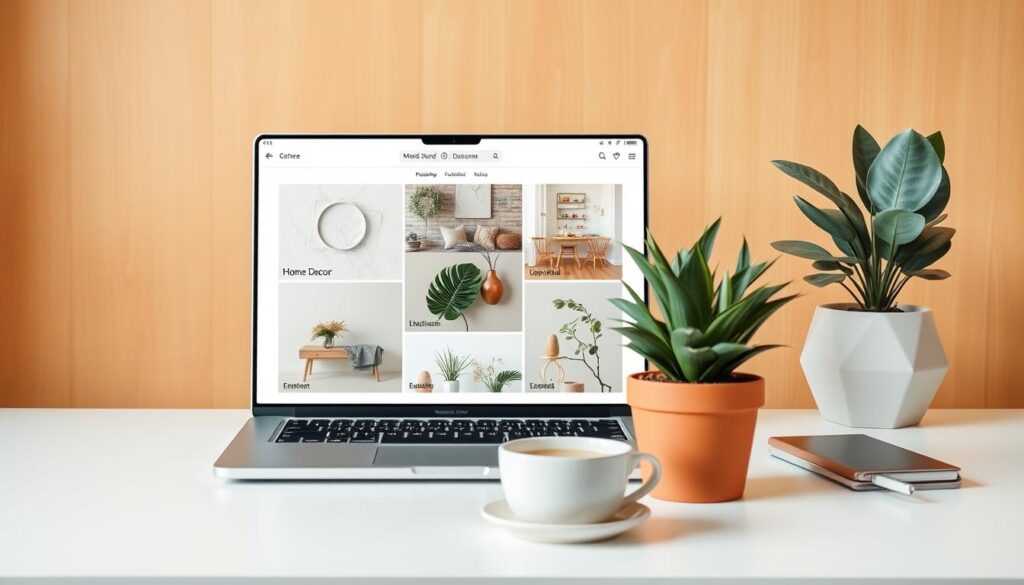
Design Styles and Their Mood Board Characteristics
In the world of interior design, mood boards are invaluable tools for bringing your creative vision to life. A well-designed mood board captures the essence of your chosen style, serving as a visual guide throughout the design process.
Modern and Contemporary Mood Boards
Modern and contemporary mood boards often feature clean lines, minimal ornamentation, and an emphasis on functionality. To create a modern mood board, focus on incorporating neutral color palettes, sleek textures, and cutting-edge furniture designs. Consider adding images of contemporary architecture and innovative materials to reinforce the modern aesthetic.
Farmhouse and Rustic Elements
Farmhouse and rustic mood boards evoke a cozy, welcoming atmosphere, often incorporating natural materials like wood and stone. To capture this style, include warm color tones, vintage or antique pieces, and textures that reflect the natural world. Distressed wood and vintage metalware can add authenticity to your farmhouse-inspired mood board.
Mid-Century Modern Inspiration
Mid-century modern design is characterized by organic shapes, geometric patterns, and an integration with nature. When creating a mid-century modern mood board, look for images that feature iconic furniture pieces from the era, such as Eames chairs or Noguchi coffee tables. Incorporate a mix of bold, graphic patterns and natural textures to capture the essence of this style.
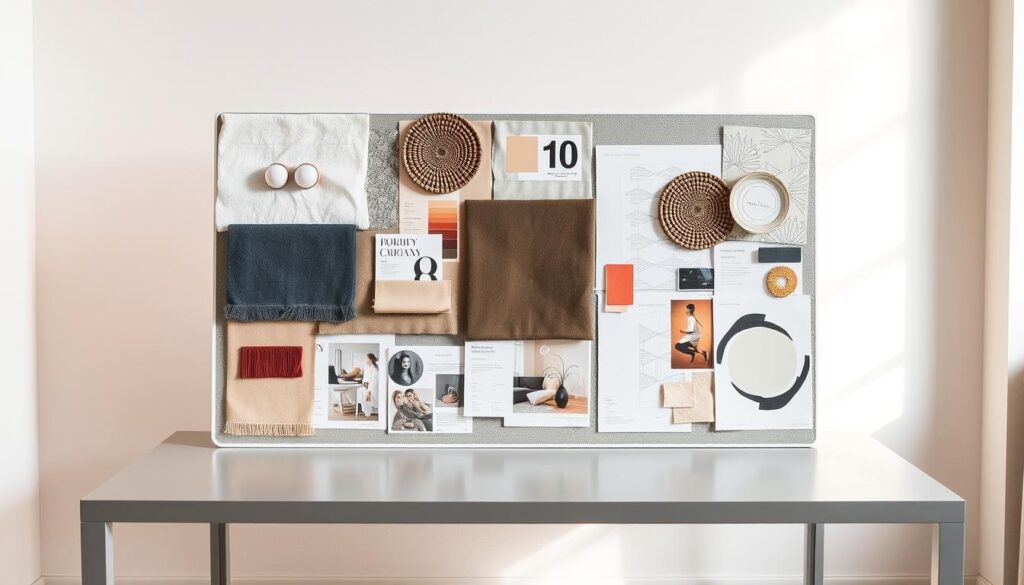
Bohemian and Eclectic Approaches
Bohemian and eclectic mood boards celebrate individuality and creativity, often combining disparate elements into a unique visual narrative. To create a bohemian-inspired mood board, gather a diverse array of textures, colors, and patterns. Include vintage or globally sourced items, and don’t be afraid to mix and match different styles and eras.
Minimalist Design Boards
Minimalist mood boards are defined by simplicity and restraint, focusing on essential elements and eliminating clutter. To achieve a minimalist aesthetic, use a limited color palette, clean typography, and plenty of negative space. Emphasize high-quality materials and subtle textures to add depth to your minimalist mood board.
By understanding the characteristics of different design styles, you can create a mood board that effectively captures your desired aesthetic, guiding your design decisions and ensuring a cohesive final result.
Room-Specific Mood Board Ideas
A well-designed mood board can make all the difference in bringing your home decor ideas to life, room by room. By tailoring your mood boards to specific rooms, you can better visualize the unique characteristics and functions of each space.
Living Room Mood Board Essentials
For the living room, consider including elements that reflect comfort and social interaction. Key components may include:
- Color palettes that promote relaxation
- Furniture styles that encourage conversation
- Texture samples like plush rugs and soft throw blankets
Don’t forget to add inspirational images or decorating with mood boards examples that showcase your desired aesthetic.
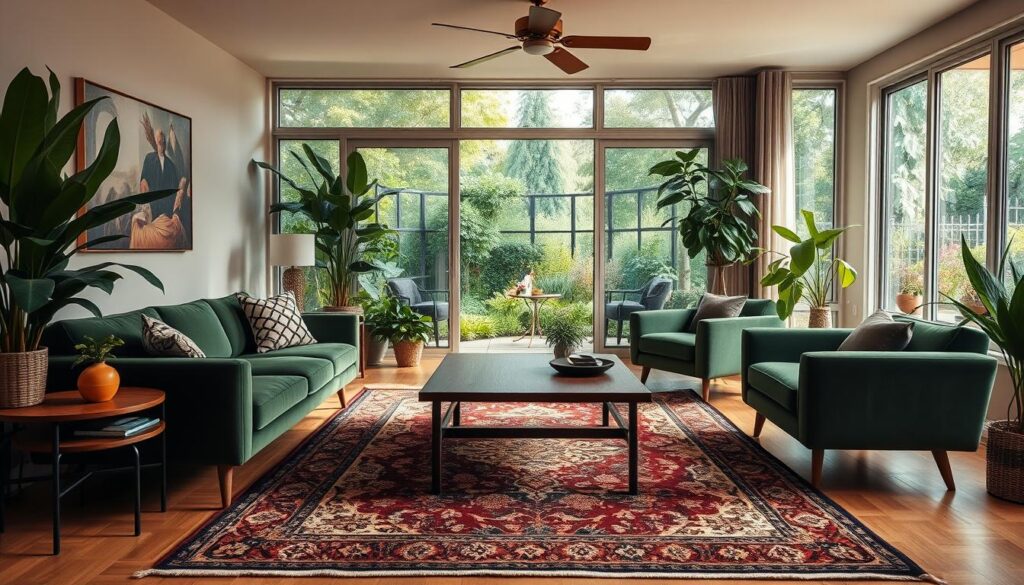
Kitchen and Dining Area Considerations
When creating a mood board for the kitchen and dining area, focus on functionality and warmth. Include:
- Cabinet styles and countertop materials
- Lighting fixtures that enhance the ambiance
- Color schemes that stimulate appetite and conversation
Bedroom Mood Board Components
For the bedroom, prioritize elements that promote relaxation and intimacy. Consider including:
- Soft color palettes and calming textures
- Furniture pieces that convey comfort and serenity
- Inspirational images of peaceful retreats
Bathroom Design Elements
In a bathroom mood board, focus on cleanliness, functionality, and relaxation. Key elements may include:
- Tile samples and color schemes that evoke serenity
- Fixture styles that combine modernity with comfort
- Lavish textures like marble or granite
Home Office and Specialty Spaces
For home offices and specialty spaces, consider the activities that will take place there and design your mood board accordingly. Include elements like:
- Furniture that promotes productivity
- Color schemes that stimulate creativity
- Storage solutions that keep the space organized
By creating room-specific mood boards, you’ll be able to visualize your home decor inspiration more effectively and make informed decisions about your design choices.
DIY Mood Board Projects for Home Decor
A DIY mood board is a fantastic tool for organizing your thoughts and inspirations for home decor. It allows you to visualize your design ideas and make adjustments before committing to specific styles or purchases.
There are several creative ways to make a DIY mood board for your home decor. Here are a few projects to consider:
Cork Board Transformation
Transform a simple cork board into a vibrant mood board by adding your favorite home decor images, fabric swatches, and color cards. Use push pins to secure your items and create a visually appealing arrangement.
Magnetic Mood Board Creation
Create a magnetic mood board using a metal sheet or a magnetic board. This is ideal for displaying small items like paint swatches, fabric samples, and inspirational photos.
Portable Folder Mood Boards
Use a portable folder to create a compact mood board. This is perfect for taking your design ideas on the go or sharing them with professionals.
Digital-to-Physical Mood Board Printing
If you prefer digital mood boards, consider printing your design. Use a high-quality printer to print your mood board on paper or cardstock, and then frame it or mount it on a board for a more polished look.
By creating a DIY mood board, you can effectively plan and visualize your home decor, ensuring a cohesive and stylish space that reflects your personal taste.
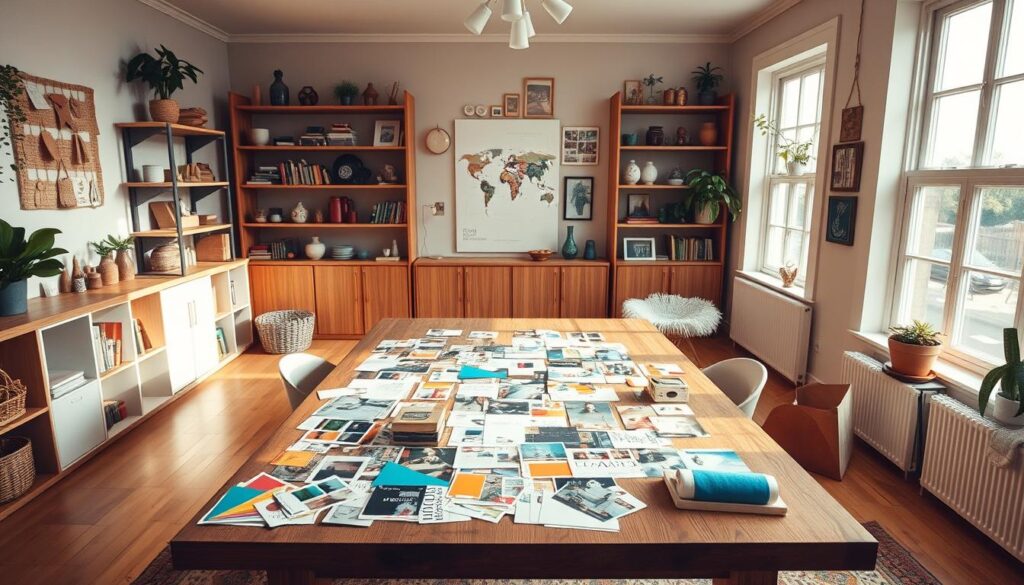
Analyzing and Refining Your Mood Board
After assembling your mood board, take a step back to assess its visual cohesion and make adjustments to achieve your desired aesthetic. This critical step ensures that your design is both beautiful and functional.
Evaluating Visual Cohesion
Begin by evaluating the overall visual cohesion of your mood board. Ask yourself if the colors, textures, and images you’ve chosen work well together. Consider the balance of elements and whether any stand out too much or get lost in the design.
Testing Different Arrangements
Don’t be afraid to experiment with different arrangements of your mood board elements. Try rearranging the layout to see if a different configuration improves the overall look and feel. This process can help you discover new ways to present your design concept.
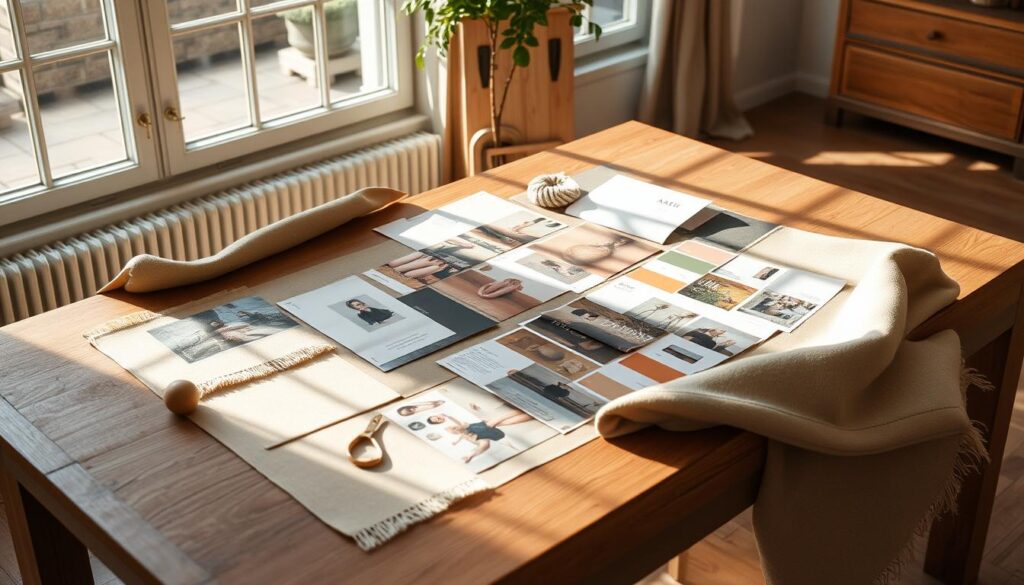
Getting Feedback from Others
Share your mood board with friends, family, or design professionals to get their feedback. Others may notice aspects of your design that you haven’t considered, providing valuable insights to refine your concept.
Making Practical Adjustments
Once you’ve gathered feedback and made adjustments, it’s time to consider the practical aspects of your design. This includes:
- Ensuring that your design choices are feasible within your budget
- Verifying the availability of materials and products you’ve selected
Budget Considerations
When refining your mood board, it’s essential to keep budget considerations in mind. Make sure to select materials and products that fit within your allocated budget. This may involve substituting expensive items with more affordable alternatives or phasing your design implementation.
Availability of Materials
Check the availability of the materials and products you’ve chosen for your design. If certain items are discontinued or hard to find, be prepared to make substitutions or adjustments to your design.
| Aspect | Considerations | Actions |
|---|---|---|
| Visual Cohesion | Balance of colors, textures, and images | Adjust elements for better harmony |
| Budget | Cost of materials and products | Substitute expensive items, phase implementation |
| Material Availability | Availability of chosen materials and products | Make substitutions or design adjustments |
By carefully analyzing and refining your mood board, you can create a home decor design that is both aesthetically pleasing and practical to implement. This process is essential for achieving your desired home decor with a well-designed mood board.
Conclusion
Creating a mood board is a crucial step in achieving your desired home decor. By gathering inspiration and visualizing your design, you can ensure a cohesive and stylish space that reflects your personality.
With the right mood board ideas for home decor, you can explore different styles, from modern to bohemian, and create a unique look that suits your taste. Whether you’re designing a living room, kitchen, or bedroom, a mood board provides a clear direction for your project.
Home decor inspiration can come from various sources, including online resources, design books, and real-world experiences. By curating these elements into a mood board, you’ll be able to make informed decisions and avoid costly mistakes.
Start creating your own mood board today and discover the power of visual planning in bringing your home decor vision to life.



